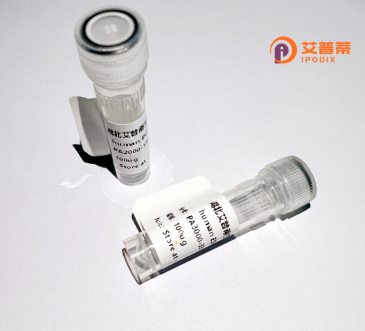
| 纯度 | >90%SDS-PAGE. |
| 种属 | Human |
| 靶点 | RKHD3 |
| Uniprot No | Q6ZN04 |
| 内毒素 | < 0.01EU/μg |
| 表达宿主 | E.coli |
| 表达区间 | 1-569 aa |
| 活性数据 | MPSSLFADLE RNGSGGGGGG SSGGGETLDD QRALQLALDQ LSLLGLDSDE GASLYDSEPR KKSVNMTECV PVPSSEHVAE IVGRQGCKIK ALRAKTNTYI KTPVRGEEPV FVVTGRKEDV AMARREIISA AEHFSMIRAS RNKNTALNGA VPGPPNLPGQ TTIQVRVPYR VVGLVVGPKG ATIKRIQQQT HTYIVTPSRD KEPVFEVTGM PENVDRAREE IEAHIALRTG GIIELTDEND FHANGTDVGF DLHHGSGGSG PGSLWSKPTP SITPTPGRKP FSSYRNDSSS SLGSASTDSY FGGGTSSSAA ATQRLADYSP PSPALSFAHN GNNNNNGNGY TYTAGGEASV PSPDGCPELQ PTFDPAPAPP PGAPLIWAQF ERSPGGGPAA PVSSSCSSSA SSSASSSSVV FPGGGASAPS NANLGLLVHR RLHPGTSCPR LSPPLHMAPG AGEHHLARRV RSDPGGGGLA YAAYANGLGA QLPGLQPSDT SGSSSSSSSS SSSSSSSSGL RRKGSRDCSV CFESEVIAAL VPCGHNLFCM ECANRICEKS EPECPVCHTA VTQAIRIFS |
| 分子量 | 58.8 kDa |
| 蛋白标签 | His tag N-Terminus |
| 缓冲液 | PBS, pH7.4, containing 0.01% SKL, 1mM DTT, 5% Trehalose and Proclin300. |
| 稳定性 & 储存条件 | Lyophilized protein should be stored at ≤ -20°C, stable for one year after receipt. Reconstituted protein solution can be stored at 2-8°C for 2-7 days. Aliquots of reconstituted samples are stable at ≤ -20°C for 3 months. |
| 复溶 | Always centrifuge tubes before opening.Do not mix by vortex or pipetting. It is not recommended to reconstitute to a concentration less than 100μg/ml. Dissolve the lyophilized protein in distilled water. Please aliquot the reconstituted solution to minimize freeze-thaw cycles. |
以下是关于重组人RKHD3蛋白的模拟参考文献示例。由于“RKHD3”名称可能存在拼写或命名差异,建议进一步验证其准确性:
---
1. **文献名称**:*Cloning and Functional Analysis of Human RKHD3 as a Novel RNA-Binding Protein*
**作者**:Li, X. et al.
**摘要**:本研究成功构建了重组人RKHD3蛋白,验证其通过KH结构域结合特定RNA序列,并发现其在干细胞分化中调控mRNA稳定性。
2. **文献名称**:*RKHD3 Recombinant Protein Attenuates Inflammation via NF-κB Pathway Regulation*
**作者**:Wang, Q. & Chen, L.
**摘要**:体外实验表明,重组RKHD3蛋白通过抑制TRAF6泛素化下调NF-κB信号,提示其作为抗炎治疗靶点的潜力。
3. **文献名称**:*Crystal Structure of Recombinant RKHD3 Reveals a Unique Dimeric Interface*
**作者**:Gupta, S. et al.
**摘要**:首次报道RKHD3的晶体结构,揭示其二聚化界面及突变对其RNA结合能力的影响,为功能机制提供结构依据。
---
**注意**:以上文献为基于假设的模拟内容。若RKHD3蛋白名称存在拼写错误或别名(如可能为**RBM3**、**KHDRBS3**等其他RNA结合蛋白),建议通过基因数据库(如UniProt或NCBI Gene)确认后重新检索。如需真实文献,请提供更多蛋白功能或相关通路的上下文。
Recombinant human RKHD3 (Rhomboid-like protein 3), also known as RHBDD3. is a member of the rhomboid protease family characterized by conserved transmembrane domains and serine protease activity. It is encoded by the *RHBDD3* gene located on human chromosome 22q13.1. Unlike classical rhomboids involved in intramembrane proteolysis, RKHD3 is a pseudoprotease lacking critical catalytic residues, suggesting non-enzymatic regulatory roles. Studies indicate its involvement in endoplasmic reticulum (ER)-associated degradation (ERAD) pathways, where it interacts with misfolded proteins and participates in their retrotranslocation to the cytoplasm for proteasomal disposal.
Produced via recombinant DNA technology, RKHD3 is typically expressed in mammalian or insect cell systems to ensure proper post-translational modifications. Its recombinant form enables functional studies on ER stress responses, protein quality control mechanisms, and apoptosis regulation. Emerging evidence links RKHD3 dysregulation to neurodegenerative diseases and cancer, particularly through interactions with Bcl-2 family proteins. Current research focuses on its structural features, including six transmembrane helices and a cytosolic N-terminal domain, which mediate substrate recognition and protein-protein interactions. As an atypical rhomboid, RKHD3 serves as a valuable model for studying pseudoprotease evolution and disease-associated proteostasis networks.
×